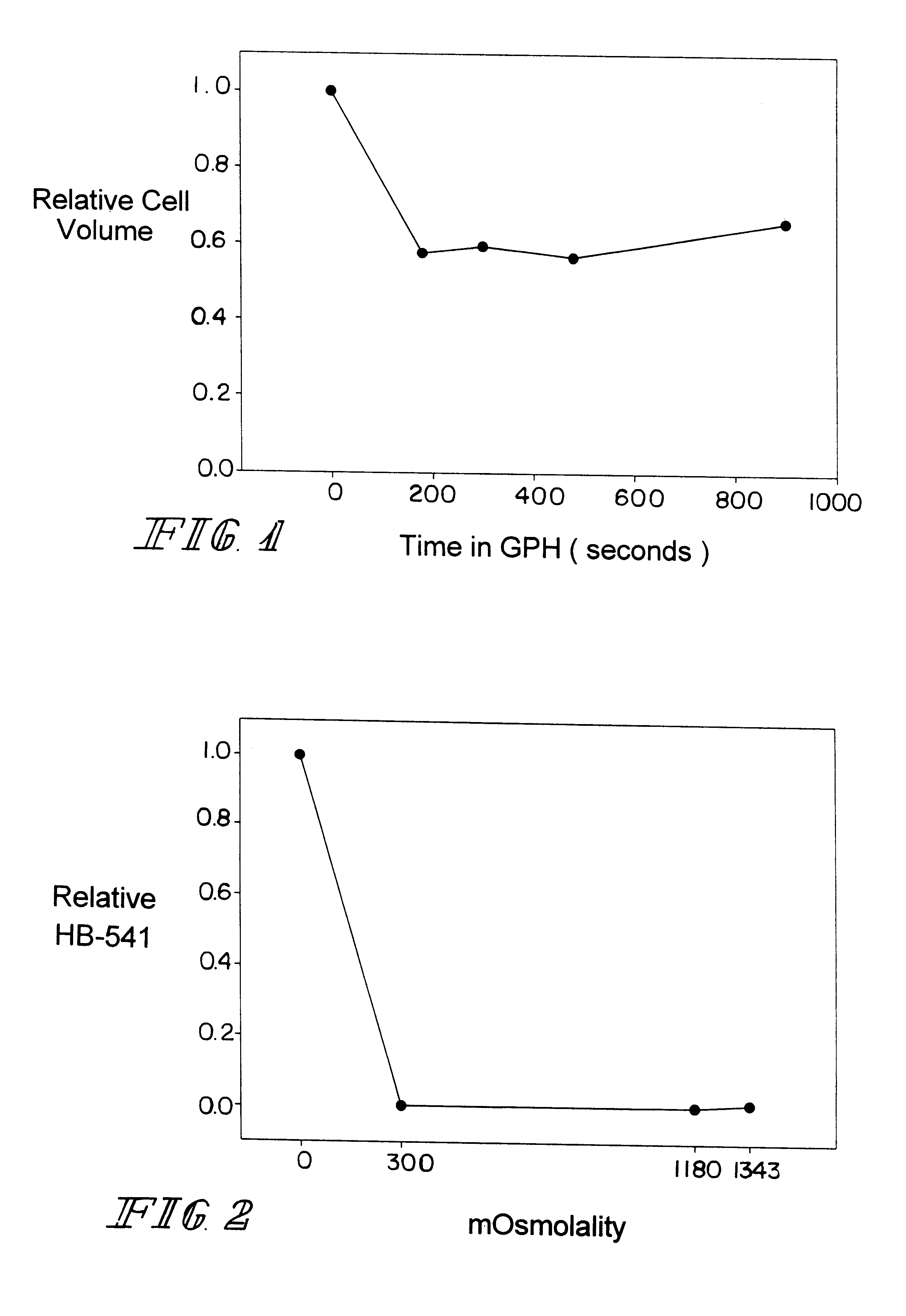Enzymatic method for removal of cryoprotectants from cryopreserved animal cells
a technology of cryoprotectant and cryopreserved animal cells, which is applied in the field of enzymatic method for removal of cryoprotectants from cryopreserved animal cells, can solve the problems of destroying biological cells and tissues, unable to discover blood-borne diseases with a latency period longer than 14 days, and unable to detect blood-borne diseases in donors, etc., to achieve controllable conversion rate
- Summary
- Abstract
- Description
- Claims
- Application Information
AI Technical Summary
Benefits of technology
Problems solved by technology
Method used
Image
Examples
example 1
Use of Glycerol Kinase to Remove Glycerol from Cells in a Single Step Process
Glycerol kinase (GK) catalyzes the following reaction: ##EQU2##
Glycerol kinase is found widely in nature (Thorner and Paulus, 1973). In microorganisms GK is involved in the utilization of glycerol as a carbon source. In mammals, the enzyme in involved in fat and sugar metabolism (Kida et al., 1973). GK phosphorylates glycerol exclusively to L-[[alpha]]-glycerophosphate. The reaction is essentially irreversible and Mg.sup.2+ is required (Zwaig and Lin, 1966, Hayashi and Lin, 1967; Thorner and Paulus, 1973). The activity of this enzyme is characterized in terms of the ability of the enzyme to convert 1.0 .mu.M glycerol to L-glycerol, 3-phosphate / min at 25.degree. C.
Many cells, such as red blood cell, used widely in transfusion medicine, are cryopreserved using 1-3 M concentrations of glycerol. One of the major rate limiting factors using current protocols for freezing red blood cells, is the time it takes to ...
example 1a
Determination of Human RBC Cell Volume in the Presence of Glycerol Phosphate
Media: 950 mg of L.alpha.GPH were placed into 6.42 ml of isotonic phosphate buffered saline (PBS) to yield a 0.4 M concentration of L.alpha.GPH. The corresponding osmolality was 1340.+-.3 mOsm.
Experimental procedure: Human red cells were abruptly exposed to the 0.4 M L.alpha.GPH solution and the cell volume over time was determined using a modified Coulter counter apparatus. The results are shown in FIG. 1. Human RBC volume was reduced to 58% of their isosmotic volume within 3 minutes and the cell volume remained reduced for 15 minutes. These data demonstrate that L.alpha.GPH is impermeable to the human red cell plasma membrane.
example 1b
Determination of Human RBC Lysis in the Presence of L.alpha.GPH
Media: Reagent grade distilled water (negative control; 100% lysis expected), isotonic PBS (positive control, 0% lysis expected) and 1180 and 1340 mOsm glycerol-phosphate solutions were used.
Experimental procedure: Human red cells were exposed for 20 minutes to one of the four treatment media listed above. After 20 minutes, the cells were placed into a spectrophotometer and absorbance at 541 nm measured to determined the amount of hemoglobin in free solution as a measure of cell lysis. The distilled water treatment was used as the negative control and assumed to produce 100% cell lysis. The other values were normalized to this value. The results are shown in FIG. 2. No cell lysis was observed in either the isosmotic PBS control (positive control) or the L.alpha.GPH solutions. These data indicated that concentrations of L.alpha.GPH to remove glycerol from human red cells are not damaging.
PUM
| Property | Measurement | Unit |
|---|---|---|
| Temperature | aaaaa | aaaaa |
| Concentration | aaaaa | aaaaa |
| Permeability | aaaaa | aaaaa |
Abstract
Description
Claims
Application Information
 Login to View More
Login to View More - R&D
- Intellectual Property
- Life Sciences
- Materials
- Tech Scout
- Unparalleled Data Quality
- Higher Quality Content
- 60% Fewer Hallucinations
Browse by: Latest US Patents, China's latest patents, Technical Efficacy Thesaurus, Application Domain, Technology Topic, Popular Technical Reports.
© 2025 PatSnap. All rights reserved.Legal|Privacy policy|Modern Slavery Act Transparency Statement|Sitemap|About US| Contact US: help@patsnap.com



